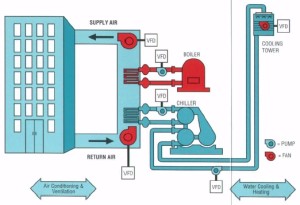 HVAC stands for Heating, Ventilation, and Air Conditioning. These systems are the main climate and air quality regulators for homes and commercial buildings. Modern HVAC systems are sophisticated and reliable pieces of equipment but that has not always been the case. Even though advances in the reliability and cost effectiveness of HVAC systems continue to improve, we are at a stage in their development where they are already greatly improved.
HVAC stands for Heating, Ventilation, and Air Conditioning. These systems are the main climate and air quality regulators for homes and commercial buildings. Modern HVAC systems are sophisticated and reliable pieces of equipment but that has not always been the case. Even though advances in the reliability and cost effectiveness of HVAC systems continue to improve, we are at a stage in their development where they are already greatly improved.
A man named Willis Hayiland Carrier invented air conditioning in 1902. It has been in continual development ever since. Carrier invented a system that was used in a printing plant to help regulate the humidity and temperature in the building. It caused the plant to operate more consistently and reliably and subsequently, it grew from there. Carrier formed his own company when demand for these systems exploded commercially. They were used almost entirely by industrial buildings; residential systems were not common until the 1950s.
Early air conditioning systems used flammable and toxic gases to cool the air, which limited their use. In 1928, Thomas Midgley, Jr. introduced the first systems to use chlorofluorocarbons, more commonly known as CFCs. DuPont took the idea and branded theirs Freon and it made the systems much safer and more reliable.
In the 1970s, scientists found evidence that the CFCs being released into the atmosphere were depleting ozone levels in the stratosphere which in turn was letting more harmful ultraviolet sun rays and radiation reach the surface of the earth. Over time, the use of CFCs has been restricted and as of 2010 they are no longer used at all in air conditioning and refrigeration units. Newer non-ozone-depleting refrigerants have been developed and are now used to create safer HVAC systems.
Engineering was further improved in the 1980s as indoor air quality started becoming an important issue. New filtration methods and ways to increase the amount of fresh, outdoor air used by the systems have been developed and implemented. These developments keep our homes more ventilated without sacrificing energy efficiency.
While these systems have become more energy efficient over the past couple of decades, the primary focus of many manufacturers is still efficiency. Today we enjoy safe, efficient, and reliable HVAC technology. As an essential part of our daily lives, these systems will continue to be adapted to our changing needs by today’s graduating scientists and engineers.
Mckinnon Heating and Cooling is a Toronto area HVAC contractor specializing in design and installation of air conditioning systems for residential and commercial projects of any size. Call us with any questions about your system.
